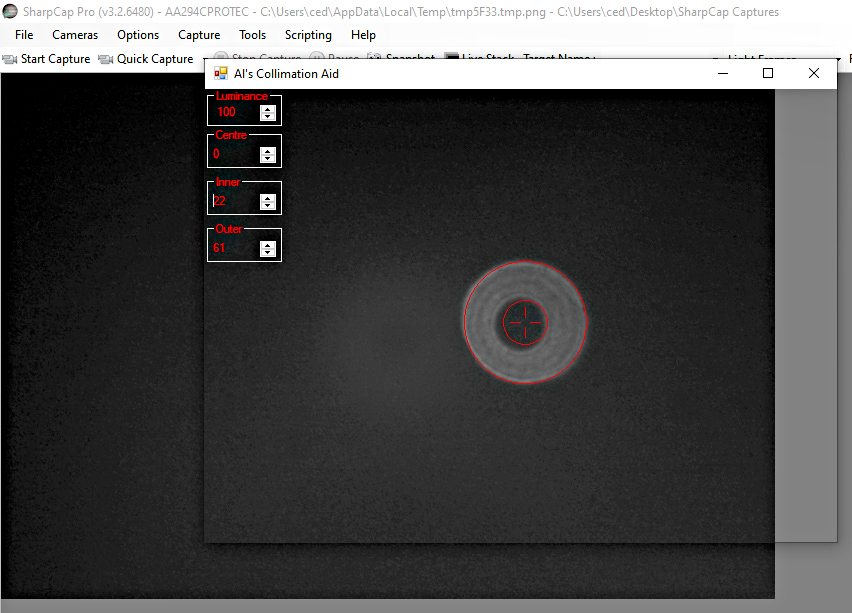[This is just one of many articles in the author’s Astronomy Digest.]
These telescopes are not the easiest to collimate – particularly one as large as my 9.25 inch Celestron. They can really only be done accurately by centring the shadow of the secondary mirror within the out of focus image of a star. The problem is that, as a slight adjustment is made to the three screws controlling the position of the secondary mirror, the position of stellar disk moves. Manually altering the telescope pointing to bring the disk back into the centre of the field of view is not easy and it would be ideal if this could be achieved by using the slew commands of the mount supporting the telescope. The problem with using an artificial star is that the mount will be siderealy tracking and so the artificial star will move out of the field of view. So a real star makes this easier, but the atmosphere will degrade the stellar image unless the seeing is very good.
The optimum strategy is to move the stellar disk to the edge of the field of view in the direction where the secondary shadow is closest to the edge of the disk. One then adjusts one of the three adjustment screws to bring the disk back towards the centre of the field. The offset of the shadow should then be less. This procedure is repeated until the secondary shadow is centred within the disk.
Having had to remove the corrector plate of my 9.25 to clean its interior surface I found that, not surprisingly, when it was replaced the telescope was way out of collimation. I made a couple of attempts to visually observe the out of focus image of an artificial star with telescope positioned on a fixed mount moving each time to the front of the telescope to adjust the collimation screw. This really did not work for me.
I realised that if I were tracking a ‘real’ star, I could use the telescope’s fine slew commands to adjust the position of the stellar image and that the ease at which the collimation process can be done would be greatly helped if a camera is used to image the disk with the screen of the laptop controlling the camera located where it could easily seen from the front of the telescope. Thus, adjustments can be made whilst observing the stellar image and mount adjustments could be made using the fine slew commands.
During the evening of September 16th 2021, Altair was at a suitable elevation – high enough so that the atmosphere would not affect the image too much but low enough so that the collimation screws could be easily reached. Obviously one cannot use a dew shield and so, as it was a dewy night, after a while I had to use a hair drier to remove the dew from the corrector plate. An Altair Astro 294C colour camera having Micro 4/3 sensor was used to image the star. The relatively large sensor meant that fine adjustments to the collimation screws did not move the image out of the field of view.
This process made collimating the SCT far easier and the final adjustments were made using a neat software program called ‘AlsCollimationAid’. When opened, this produces an overlay that can be placed over the image of the stellar disk with two circles; one to surround the disk and the other the shadow of the secondary mirror. Their sizes can be adjusted as the overlay is centred on the stellar image. This makes it very easy to see when the telescope is perfectly collimated.
To get this nice piece of software, go to this website and click on the download link which is at the very bottom.
http://sweiller.free.fr/collimation.html
The image below shows the overlay when the collimation process was nearly complete.

